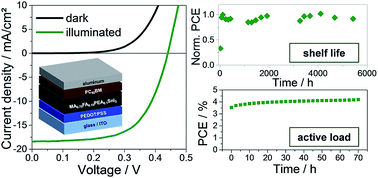Photovoltaic properties of a triple cation methylammonium/formamidinium/phenylethylammonium tin iodide perovskite†
Abstract
Compositional engineering of the tin perovskite absorber layers as well as their crystallization and film formation processes are key parameters for further development of tin perovskite solar cells. Herein, we present a triple cation tin perovskite comprising methylammonium (MA), formamidinium (FA) and phenylethylammonium (PEA) as A-cations with the composition MA0.75FA0.15PEA0.1SnI3. This MA-rich mixed 2D/3D perovskite shows an extended photocurrent generation up to a wavelength of 1000 nm. Moreover, we found that a two-step antisolvent dripping process combined with placing the substrate onto a pre-heated heating plate at 70 °C directly after spin coating leads to very smooth and nearly pinhole-free tin perovskite films. Solar cells with the optimized absorber layer processing conditions showed power conversion efficiencies up to 5.0% and notably good stability. After more than 5000 h of storage under glovebox conditions, still 87% of the initial power conversion efficiency is retained and further stability tests under active load and continuous illumination also revealed exceptional stability of these solar cells in operation. Furthermore, by investigations of the dependence of the photovoltage on light intensity an ideality factor of 1.1 kT/q was found indicating that trap-mediated recombination processes play only a minor role in the triple cation based tin perovskite solar cells.



 Please wait while we load your content...
Please wait while we load your content...